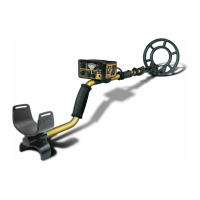get a response. Keep in mind that for accurate target ID,
the coil center must pass directly over the target.
5. Note the response you get over small targets. For small
iron or steel targets, the meter needle will usually lock in
the “IRON” category. Most pull tabs, foil, nickels and the
newer zinc pennies will also be correctly classied. Silver
coins, copper coins, and the newer clad coins will ID in
the highest category.
6. Note that an enlongated ferrous object such as a nail will
give you a double “beep” as you cross it from end to end
and a single “beep” if you cross its center.
7. Most silver rings will ID at the highest end of the scale. If you
have enough gold rings you will note that some fall in the
round tab category, some in the “FOIL” category, some
in the square tab category, a few in the nickel category,
and very few in the remaining coin categories. This is
due to the fact that the combination of size, shape and
conductivity of a particular ring will almost always add
up to a target that is electronically identical to either a
piece of foil, pull tab or nickel. Most metal detectors have
a difcult time separating gold rings, nickels, tabs, and
foil, but, the patented circuitry of your CZ-3D can easily
tell the difference between nickels and most trash. Better
yet, it will allow you to nd many types of gold rings while
completely ignoring at least some types of pull tabs and
small pieces of foil.
8. Note also the different audio responses:
a) an iron target will give you a low tone
b) foil a mid low tone
c) tabs a medium tone
d) coins a high tone.
9. When you go over a large, shallow target the CZ-3D will
respond with a distinctive belltone. This is due to the fact
that metal detectors can only identify small targets. What
usually happens is that the detector circuits will overload
and identify a large target as “good” (silver, coin, etc.).
Your CZ-3D, however, will alert you to the fact that the
target is big and shallow and can not be accurately
identied. Big deep targets, however, will usually be
classied as a coin. Also, be aware that large coins on
SEARCH MODES
14
NOTE: Unlike other metal detectors, the discrimination level has little
if any effect on the depth capability of the CZ-3D. Note however, that
the all-metal, Autotune mode has a wider search pattern and may
detect a little deeper. Depth is also determined by the size, shape
and conductivity of the target as well as the sensitivity setting of
the CZ-3D.
1. Minimum Depth
a. Very slow or fast sweep speed.
b. Discrimination set at “6.”
2. Good Depth
a. Moderate sweep speed.
b. Discrimination set at “4.”
3. Maximum Depth
a. Moderate sweep speed.
b. Discrimination set at “0.”
4. Missed Target
Many targets within range will not
be detected unless you closely
overlap your sweeps.
4
1
2
3
Figure 7. SEARCH COIL DETECTION PATTERN
SEARCHING
Figure 5. SEARCH PATTERN.
When the stem length is properly
adjusted, the CZ-3D is balanced for
sweeping in a tight semicircle. Wide to
the right for right handers. Wide to the
left for left handers.Be sure to overlap
your sweeps.
19
Figure 6. COIL ORIENTATION
Keep the search coil parallel and
close to the ground at all times.

